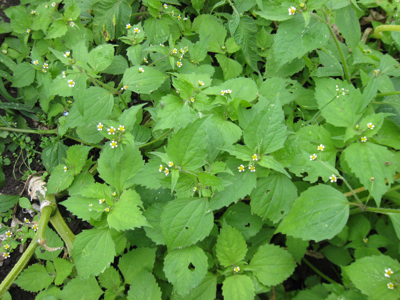
|

|
| Quickweed; Galinsoga quadriradiata Ruiz & Pav. |
| = Galinsoga ciliata (Raf.) S. F. Blake |
Sunflower Family; COMPOSITÆ (ASTERACEÆ)
|
| Quickweed is an annual herb of soft, fuzzy, unassuming appearance. It plays an inconspicuous role, with plain-shaded green
foliage cloaking its long straight stalks, and its tiny yellow-centered daisies incompletely ringed by five or six notched white petals that seem
barely big enough to do the job. |
| According to the favorableness of its growing conditions, it may be found a skinny, weak, floppy little stalk with a feeble grip
on existence, or a flourishing, sprawling and much-branched
11/2 foot tall and wide specimen. When many grow close together and are
seen in full bloom, they are neither as pretty as some weeds nor as ugly as the worst kinds; they are perhaps best described as a good
backdrop for more colorful flowers. |
| Beyond question, the most interesting thing about Quickweed is that it is one of very few South American weeds that thrives
throughout North America and Europe, even in cold areas. Its native home extends from Mexico to Chile. Asking for only sunshine and disturbed
soil, it can be found from May into December, but is fastest-growing and at its height from July through September. It is not generally
common, but is so in some places. For example it has been weedy at the University of Washington for over 50 years. |
Mariano Martinez de Galinsoga, an 18th century Spanish physician and botanist, is commemorated in the plant's generic name.
From this man's surname then was lazily corrupted an English misnomer "Gallant Soldier", which so belies the actual state of the herb
that "Shaggy Soldier" was suggested as an improvement on accuracy. "Garden Pest" is still another better name sometimes used.
"Quickweed" is presumably either English or American in origin, but who first used it and why, remains unknown. In my experience at least, the
plant doesn't grow as fast as some other weeds. An extremely similar species, also a weed (yet not in Seattle), is called by these names too
(G. parviflora). The plants, despite their light covering of fuzz, are weakly-flavored edibles, raw or cooked.
|
Originally published as the Seattle Tilth newsletter Weed of the Month in November 1987, along with an illustration from a book.
Back |
|
|

